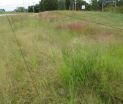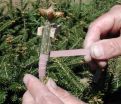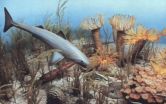(Press-News.org) KINGSTON, RI – Erosion is a significant problem on highway embankments in New England. To mitigate erosion on the regions' highways, slopes are seeded with a grass–legume mixture that usually including red fescue, a grass preferred for its drought-tolerance and ability to thrive in acidic, infertile soil. "A mixture of red fescue, perennial ryegrass, and kentucky bluegrass is planted to stabilize the soil, but only the red fescue survives long term on slopes", noted Rebecca Nelson Brown, lead author of a report in HortScience. Brown and a team from the Department of Plant Sciences at the University of Rhode Island designed a study to identify alternative grass species that could help anchor slopes and prevent costly erosion.
Twenty-two grass species were included in the study conducted in the greenhouse at the Skogley Turf Research Center of the University of Rhode Island, and in additional roadside trials on the shoulder of a nearby state highway. Since federal highway policy strongly encourages the use of native vegetation in highway right-of-ways, the researchers tested grasses native to southern New England, comparing rooting depth, plant height, and adaptation to roadside conditions. Sixteen native grasses and five amenity grasses with red fescue were tested.
Roadside embankments are generally constructed of subsoil and gravel, over which 2 to 6 inches of topsoil is spread. The subsoils are very stony with coarse-textured loamy sand between the rocks; topsoil ranges from medium textured silt to sand. Red fescue is shallow-rooted with most of the root mass confined to the topsoil layer. When root growth is concentrated in a shallow mat with a sharp boundary in the soil profile, slope failure is likely to occur beneath the mat. Identifying alternative grasses that feature more even distribution of root mass with depth could help provide better slope stabilization.
Combined results of the greenhouse and roadside trials showed little bluestem, purple lovegrass, and tall fescue to be the best choices for anchoring roadside slopes. "All species root deeply and are adapted to roadside conditions but are similar in stature to red fescue", stated Brown. The researchers found that big bluestem, indiangrass, switchgrass, and bitter panic grass also combine deep rooting with adaptation to roadside conditions, but were significantly taller than red fescue. "These grasses are likely to be too tall for use on mowed roadsides. However, to the extent that populations of these species differ in height, selection for deep rooting coupled with reduced topgrowth would be effective in developing cultivars better suited to roadside use", noted the report.
The authors observed that little bluestem and purple lovegrass are warm-season grasses and dormant from October through May, adding that the best way to use these grasses would be as a mix with red fescue and other shallow-rooted cool-season grasses with rapid vegetative spread and minimal winter dormancy. The deep-rooted species would anchor the slope, whereas the rapidly spreading species prevented surface erosion, slowed runoff, and provided the green roadsides desired by the public.
According to the study, an added benefit to using a mix of species is cost-reduction, because seed of little bluestem and purple lovegrass is substantially more expensive than seed of red fescue and other traditional turfgrasses and a mix would permit the little bluestem and purple lovegrass to be seeded at reduced rates. "This work should be useful as a guide in choosing grass species to stabilize slopes", the researchers concluded.
INFORMATION:
The complete study and abstract are available on the ASHS HortScience electronic journal web site: http://hortsci.ashspublications.org/cgi/content/abstract/45/3/393
Founded in 1903, the American Society for Horticultural Science (ASHS) is the largest organization dedicated to advancing all facets of horticultural research, education, and application. More information at ashs.org
Researchers discover potential solutions to New England roadside erosion
New grasses suggested as alternatives to red fescue
2010-12-31
ELSE PRESS RELEASES FROM THIS DATE:
Improving nitrogen use efficiency lessens environmental impact
2010-12-31
ITALY – Most agricultural crops require large quantities of nitrate-rich fertilizer to realize optimal yields. The dilemma for growers is finding ways to balance the amount of nitrogen needed for production while minimizing potentially harmful nitrates that can leach into ground and surface waters. Increased interest in environmentally beneficial "low-input" approaches is challenging researchers to identify genotypes that have a characteristic called "high nutrient use efficiency", or NUE. Using vegetable types with high NUE could help growers lessen environmental impacts ...
Can bedding plants thrive with recyled water?
2010-12-31
EL PASO, TX – To conserve dwindling water resources, municipalities are encouraging the use of "recycled water", municipal wastewater that has been extensively treated and deemed safe to reuse for irrigation and other purposes. Using recycled water can be cost-effective and helps conserve the potable supply. In areas of the U.S. where production of bedding plants means income and jobs, commercial growers are looking for ways to use reclaimed or recycled water for irrigation, but using recycled water does not come without challenges. The water can contain high levels of ...
April grafting optimal for Fraser fir
2010-12-31
RALEIGH, NC – Christmas trees provide a significant source of revenue in southern Appalachia, resulting in millions of dollars in sales during the holiday buying season. The most popular species in the region is fraser fir, appreciated for its fragrance and consumer-friendly traits such as soft needles, strong branches, exceptional needle retention, and natural Christmas tree shape. Frasers, indigenous to isolated high-elevation mountains in southwestern Virginia, western North Carolina, and eastern Tennessee, are under attack by a pathogen called Phytophthora cinnamom, ...
Large-scale analysis identifies new genetic alterations associated with height
2010-12-31
A large collaborative study has added to the growing list of genetic variants that determine how tall a person will be. The research, published by Cell Press on December 30 in the American Journal of Human Genetics, identifies uncommon and previously unknown variants associated with height and might provide insight into the genetic architecture of other complex traits.
Although environmental variables can impact attained adult height, it is clear that height is primarily determined by specific alleles that an individual inherits. Height is thought to be influenced by ...
New test announced for major killer of lung transplant patients
2010-12-31
ANN ARBOR, Mich. — A lung transplant can mean a new chance at life. But many who receive one develop a debilitating, fatal condition that causes scar tissue to build up in the lungs and chokes off the ability to breathe.
University of Michigan researchers hope a new diagnostic tool they developed to predict bronchiolitis obliterans syndrome (BOS) will allow doctors to intervene earlier and, ultimately, to provide life-saving treatments.
BOS is the leading cause of death for those who survive one year after lung transplantation and more than half of recipients will develop ...
First come, first served?
2010-12-31
Emergency department overcrowding can result in long waiting times for seriously ill patients. They then compete with patients with less severe illnesses for the next available treatment. In this edition of Deutsches Ärzteblatt International (Dtsch Arztebl Int 2010; 107[50]: 892), Michael Christ and his coauthors provide an overview of current practice for initial assessment of emergency patients.
Triage provides reliable methods that can be used to assess the severity of an illness and the urgency of treatment in emergency departments.
In English-speaking countries, ...
What triggers mass extinctions? Study shows how invasive species stop new life
2010-12-31
An influx of invasive species can stop the dominant natural process of new species formation and trigger mass extinction events, according to research results published today in the journal PLoS ONE.
The study of the collapse of Earth's marine life 378 to 375 million years ago suggests that the planet's current ecosystems, which are struggling with biodiversity loss, could meet a similar fate.
Although Earth has experienced five major mass extinction events, the environmental crash during the Late Devonian was unlike any other in the planet's history.
The actual number ...
Was Israel the birthplace of modern man?
2010-12-31
Tel Aviv ― It has long been believed that modern man emerged from the continent of Africa 200,000 years ago. Now Tel Aviv University archaeologists have uncovered evidence that Homo sapiens roamed the land now called Israel as early as 400,000 years ago ― the earliest evidence for the existence of modern man anywhere in the world.
The findings were discovered in the Qesem Cave, a pre-historic site located near Rosh Ha'ayin that was first excavated in 2000. Prof. Avi Gopher and Dr. Ran Barkai of Tel Aviv University's Department of Archaeology, who run the excavations, ...
New technology to speed cleanup of nuclear contaminated sites
2010-12-31
CORVALLIS, Ore. – Members of the engineering faculty at Oregon State University have invented a new type of radiation detection and measurement device that will be particularly useful for cleanup of sites with radioactive contamination, making the process faster, more accurate and less expensive.
A patent has been granted on this new type of radiation spectrometer, and the first production of devices will begin soon. The advance has also led to creation of a Corvallis-based spinoff company, Avicenna Instruments, based on the OSU research. The market for these instruments ...
Risk for alcoholism linked to risk for obesity
2010-12-31
AUDIO:
Addiction researchers at Washington University School of Medicine in St. Louis have noticed an unexpected link between alcoholism risk and obesity. They report when a person has a genetic risk...
Click here for more information.
Addiction researchers at Washington University School of Medicine in St. Louis have found that a risk for alcoholism also may put individuals at risk for obesity.
The researchers noted that the association between a family history of alcoholism ...
LAST 30 PRESS RELEASES:
Why nail-biting, procrastination and other self-sabotaging behaviors are rooted in survival instincts
Regional variations in mechanical properties of porcine leptomeninges
Artificial empathy in therapy and healthcare: advancements in interpersonal interaction technologies
Why some brains switch gears more efficiently than others
UVA’s Jundong Li wins ICDM’S 2025 Tao Li Award for data mining, machine learning
UVA’s low-power, high-performance computer power player Mircea Stan earns National Academy of Inventors fellowship
Not playing by the rules: USU researcher explores filamentous algae dynamics in rivers
Do our body clocks influence our risk of dementia?
Anthropologists offer new evidence of bipedalism in long-debated fossil discovery
Safer receipt paper from wood
Dosage-sensitive genes suggest no whole-genome duplications in ancestral angiosperm
First ancient human herpesvirus genomes document their deep history with humans
Why Some Bacteria Survive Antibiotics and How to Stop Them - New study reveals that bacteria can survive antibiotic treatment through two fundamentally different “shutdown modes”
UCLA study links scar healing to dangerous placenta condition
CHANGE-seq-BE finds off-target changes in the genome from base editors
The Journal of Nuclear Medicine Ahead-of-Print Tip Sheet: January 2, 2026
Delayed or absent first dose of measles, mumps, and rubella vaccination
Trends in US preterm birth rates by household income and race and ethnicity
Study identifies potential biomarker linked to progression and brain inflammation in multiple sclerosis
Many mothers in Norway do not show up for postnatal check-ups
Researchers want to find out why quick clay is so unstable
Superradiant spins show teamwork at the quantum scale
Cleveland Clinic Research links tumor bacteria to immunotherapy resistance in head and neck cancer
First Editorial of 2026: Resisting AI slop
Joint ground- and space-based observations reveal Saturn-mass rogue planet
Inheritable genetic variant offers protection against blood cancer risk and progression
Pigs settled Pacific islands alongside early human voyagers
A Coral reef’s daily pulse reshapes microbes in surrounding waters
EAST Tokamak experiments exceed plasma density limit, offering new approach to fusion ignition
Groundbreaking discovery reveals Africa’s oldest cremation pyre and complex ritual practices
[Press-News.org] Researchers discover potential solutions to New England roadside erosionNew grasses suggested as alternatives to red fescue



